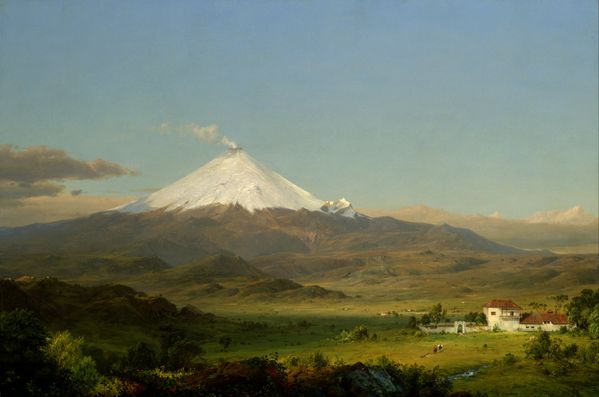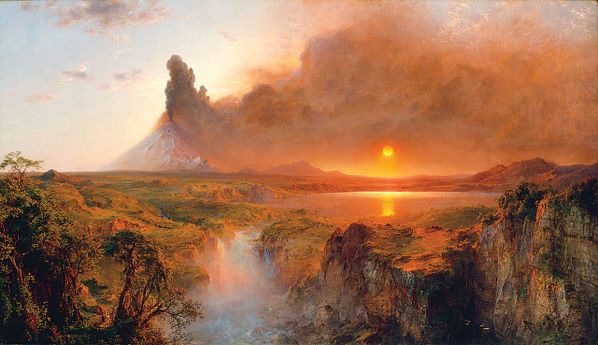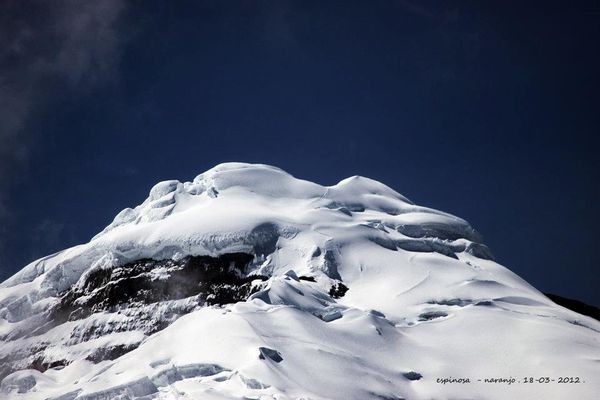Actualité volcanique, Articles de fond sur étude de volcan, tectonique, récits et photos de voyage
This Ecuadorian stratovolcano was
painted several times by Church , based on his travels in South America by the Andes mountains and volcanoes.
Frederic Edwin Church (1826-1900) was a pupil of Thomas Cole, considered as the founder of the Hudson River School , an
American art movement grouping landscape painters in the aesthetic vision of romance imprint .
Inspired by the works of Alexander von Humboldt, a German naturalist and explorer who visited the American continent from 1799 to 1804, Church went to explore the magnificent scenery twice, in
1853 and 1857.
 Cotopaxi - by Frederic Edwin Church - Oil on canvas - 1855 - Museum of Fine Arts / Houston
Cotopaxi - by Frederic Edwin Church - Oil on canvas - 1855 - Museum of Fine Arts / Houston
Cotopaxi, described by von Humboldt as the most aesthetic volcano in the region and one of the busiest , became a favorite subject of the painter.
He made a first work in 1855 , where he
portrayed a perfect cone , covered with snow and quietly dominate a tropical landscape ( above) . The volcano smoke slightly , providing a living and not aggressive note to this painting .
 Cotopaxi - another work by Frederic Edwin Church - Oil on canvas - 1855
Cotopaxi - another work by Frederic Edwin Church - Oil on canvas - 1855
Smithsonian American Art Museum
His work from 1861 to 1862 has a different atmosphere: Cotopaxi is in violent
eruption .
Church takes the volcano as a demonstration of the power of nature and will intensify each characteristic to suggest a conflict between the forces of darkness and those of light .
 Cotopaxi - by Frederic Edwin Church - Oil on canvas - 1862 - Detroit Institute of Arts
Cotopaxi - by Frederic Edwin Church - Oil on canvas - 1862 - Detroit Institute of Arts
Enlarge by clicking
here
The roaring volcano, the low sun veiled by fumes ash, the large waterfall plunging into a rocky canyon whose sides reveal a tormented geological history ... all highlights incredible
forces.
These
are tempered by the green color of the foliage in the foreground , with the sunlight penetrating the volcanic cloud and its reflection on a lake with calm waters ... signs that this burst of
energy remains under the control of a welfare benefit . The volcano is a source of destruction, but also of creation and rebirth.
The high point of view, which puts the viewer in levitation, accentuates the contrasts .
This style of landscape
painting also ranked in the " Luminist " current, considered an offshoot of the Hudson River School ( between 1850 and 1870). It is characterized by
attention to the effects of light, the use of aerial perspective, and concealing visible brush cops .
 The snow-capped Cotopaxi - Photo José Luis Espinosa -
Naranjo 03.2012
The snow-capped Cotopaxi - Photo José Luis Espinosa -
Naranjo 03.2012
Cotopaxi has a violent
volcanic history , marked by frequent explosions generated pyroclastic flows and lahars .
Between 1803 and 1895 , more than thirty of these eruptions occurred , the most important in 1877, of VEI 4 , which produced devastating lahars in the adjacent valleys, destroying part of the
city of Latacunga , causing many casualties there before reaching the Pacific Ocean , 270 km . east of the volcano. His last event is dated from 1940.
Sources :
- From Alexander von Humboldt to Frederic Edwin Church : voyages of scientific exploration and artistic creativity - By Frank Baron 2005
- The worlds of Frederic Edwin Church - By William Gerdts 2008 - link
- Global Volcanism Program - Cotopaxi
Thème Magazine - Hébergé par Overblog


